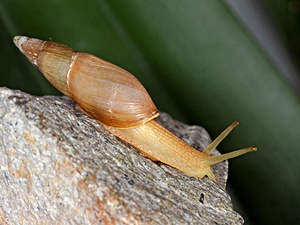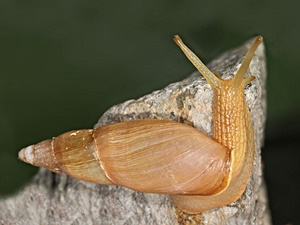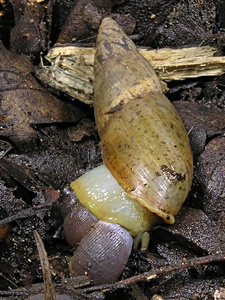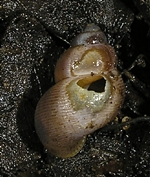
Dalmatian predator snail (Poiretia cornea) from the
Durmitor Mountains in Montenegro.

Pictures: Dragiša Savić (Source).
Poiretia cornea (Brumati, 1838) - Fam. Oleacinidae
 Dalmatian predator snail (Poiretia cornea) from the Durmitor Mountains in Montenegro. |
 Pictures: Dragiša Savić (Source). |
Description: The shell of Poiretia cornea is of a light brownish-yellow colour, more slender than Poiretia dilatata and less bulbous with fine growth stripes. The suture between the shell whorls displays an irregularly jagged thread-like margin. The aperture is narrow (about 5.5 to 9.5 mm wide), and the columella (shell spindle) is only a little curved.
![]() Picture: H. Zell:
Shell view of Poiretia cornea (new window).
Picture: H. Zell:
Shell view of Poiretia cornea (new window).
Dimensions: W: 10 - 17 mm; H: 32 - 47 mm;
N: 5 - 6 ˝.
![]()
 |
 Acid damage of a Poiretia dila- tata on the shell of Pomatias elegans, an operculate land snail. Left: Poiretia dilatata attacking Pomatias elegans. Photos: Fabio Liberto. |
Habitat and Distribution: The Dalmatian predator mainly lives in dry Macchia and open forests in the Karst country along the Adriatic coast. According to Kittel (1997) the snails sometimes also appear in anthropogenic areas, such as gardens and parks. Poiretia cornea is mostly nocturnal and hides in daytime, though it is sometimes also encountered during the day in humid or rainy weather (vgl. Wagner, 1952; Maassen, 1977; Kittel, 1997). During daytime and in dry weather the snail hides under rocks and leaves. Then it digs into the ground with its shell upright, so sometimes the shell tip can still be seen over ground. During estivation, it closes the shell aperture with an epiphragm made of dried mucus (Kittel, 1997).
In its natural habitat, the Dalmatian predator snail feeds on other snails, apart from operculate snails also larger snails and door snails (Clausiliidae) and even earthworms (see Wächtler 1927, Maassen 1077 und Kittel 1997). The shells of snails attacked by Poiretia cornea can often be recognized by etched areas and holes in the shell, especially operculate snails and door snails (also see: "Predazione di Poiretia"). If the prey's shell aperture is big enough so the predator can get in with its head, it will also eat its prey directly through the aperture. Here Klaus Kittel was able to observe that Poiretia cornea also successfully attacks snails noticeably bigger than itself (e.g. adult Cornu aspersum or Eobania vermiculata). Apparently, it is quite harder for the Dalmatian predator to hunt slugs, which it cannot get a good hold on because of the slug's resilient back skin and slimy exterior. Poiretia, however, will try.
The natural distribution area of the Dalmatian predator snails spreads from
Monfalcone in northeastern Italy over southwestern Slovenia, Croatia (i.e.
Istria and Dalmatia, coastal areas of Bosnia, Herzegowina and Montenegro, as far
as Southern Albania. Separated distribution areas are on the Gargano peninsula in
eastern Italy and eastern Libya (Cyrenaica province), where the species might
have been introduced by man (![]() Distribution map).
Distribution map).
Systematics: According to Subai (1980), the Poiretia genus contains six recent species, among which are the name-giving species Poiretia algira (Bruguičre, 1792) and Poiretia cornea (Brumati, 1838). With one exception, all species occur in the Mediterranean. In the system by Bouchet and Rocroi (2005) the Poiretia genus is placed within the subfamily Euglandininae and the family Oleacinidae. The genera Poiretia and Sardopoiretia emanueli (Bodon, Nardi, Braccia & Cianfanelli, 2010) are the only members of this family present in the Mediterranean (or in Europe for that matter), the rest of the Oleacinidae family, including the rosy wolf snail (Euglandina rosea) are distributed in the Neotropic zone: Central America and the Caribbean.
The placement of the Euglandininae subfamily within the Oleacininae family is not uncontested. Contrary to the Bouchet and Rocroi system, Thompson (2010) places the Euglandininae within the Spiraxidae family. However, according to Helwerda (2015), this change is not universally accepted. As a consequence, especially American sources and Wikipedia use the Thompson systematics, whereas Bank et al. in Fauna Europaea use a system based on Bouchet and Rocroi, however placing the new genus Sardopoiretia outside of the Euglandininae.
|
Dalmatian predator (Poiretia cornea) from Croatia. Video by Walter Pfliegler on YouTube. |
Pictures:
Book:
Literature: